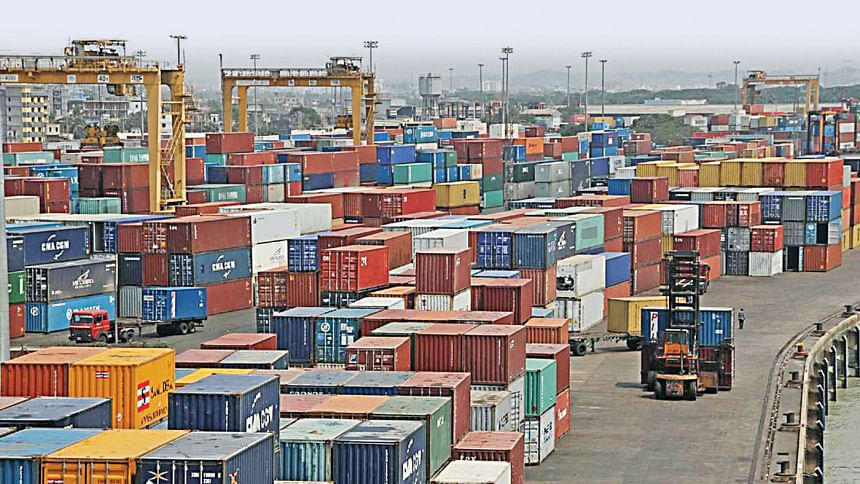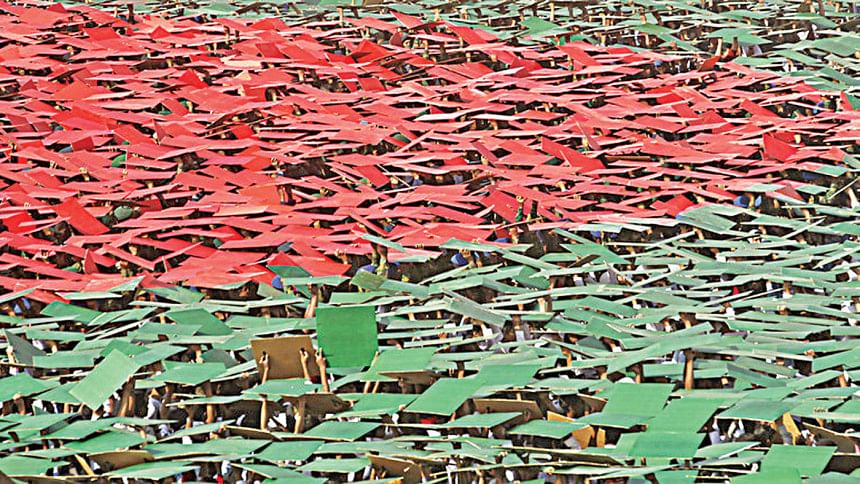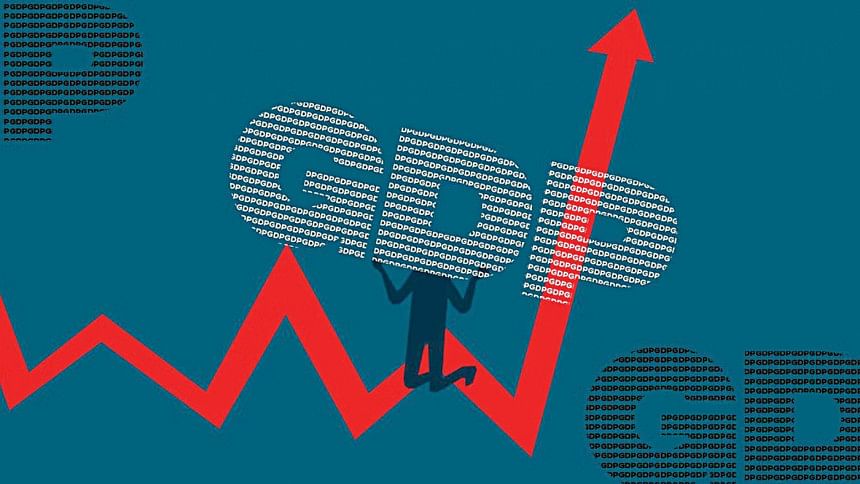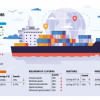The rapid growth of Bangladesh’s economy, and what comes after

Growth has been the constant in the journey of the Bangladesh economy over the last two decades. Starting from 2004, excluding the outlier year of 2020 when the world economy was severely affected by the Covid-19 pandemic, Bangladesh has maintained a growth rate of over five percent or more. Since 2011, this rate has stayed above six percent as well (excluding 2020), indicating rapid growth that puts Bangladesh in the category of one of the fastest growing economies in the world.
So, what has primarily driven this growth?
The story of economic growth in Bangladesh has two main characters—ready-made garments (RMG) and remittance. Their contribution to the GDP in fiscal year 2023—10.35 percent by the RMG sector and 4.76 percent by remittance—shows that these sectors are vital cogs for the economy. But the picture of their pivotal role is better painted when these sectors' contribution as foreign exchange earners is considered. RMG makes up an overwhelming 84.58 percent of Bangladesh's total exports in FY23. Remittances made up 41.29 percent of export earnings and also contributed to 31.10 percent of import payments, indicating a net gain.
In the background is the steady contribution of the agricultural sector, which has made up 11.20 percent of the GDP in the most recently concluded fiscal year. Historically, especially in the last 20 years when Bangladesh has seen sustained growth, this contribution has slowly declined. This indicates a growth pattern in the economy that has slowly shifted towards industries over agriculture, and the data supports it as well, with contribution of industry (including construction) to GDP rising steadily during this time.
Bangladesh's sustained economic growth makes it one of the fastest growing economies in the region. The Asian Development Bank, in its Asian Development Outlook for 2019, said that Bangladesh achieved the fastest growth among economies in the Asia-Pacific during that fiscal year. In late 2023, according to the annual economic outlook of Mastercard Economics Institute (MEI), Bangladesh was predicted to be the second fastest growing economy among 46 countries, second only behind neighbouring India.

But growth is only part of the picture. The fact that the Bangladesh economy has shown notable prowess in achieving sustained, rapid growth is beyond doubt, but what is its impact on the lives of people? Is this growth going to be enough to face the challenges in the near and distant future?
Dr Selim Raihan, Professor at the Department of Economics at Dhaka University, spoke to The Daily Star about what this economic growth has meant to Bangladesh in real terms.
"Growth is necessary, because without growth people's incomes won't grow, overall economic activity won't expand. But the more important question is how this growth is happening, what the sources of growth are. An even deeper question is how inclusive this growth is," he said.
"The sources of growth are heavily driven by export of RMG, remittance, and infrastructural development in recent decades. Agriculture sector development has also helped sustain this growth. But the base of this growth still isn't that strong. In export, we depend on a single commodity, the dependence on remittance is also an issue as the earnings fluctuate from year to year. The economic growth we have experienced in the last two decades will be quite challenging to sustain in the same way going forward. There has been little success in economic or export diversification, large scale foreign direct investment has not been attracted either. We have to find ways to make our economic growth broader based and find new sources of growth," he added.

On the topic of making growth more inclusive, he said, "The story of job creation in Bangladesh is not as strong as the story of economic growth. While poverty alleviation has mostly been successful in our country, the speed at which it should have happened at this time of rapid growth in Bangladesh was never achieved. A big concern is that along with growth, income inequality has also become a bigger problem."
When asked about the future growth prospect of the Bangladesh economy on the back of the last few decades, Dr Rashed Al Mahmud Titumir, Chairman and Professor of Economics at the Department of Development Studies at Dhaka University, said that his models estimate that the Bangladesh economy would reach a trillion dollars in 2033, but only under certain conditions. He referred to the chapter titled, "Towards a Trillion-Dollar Economy: Reflections on and Prospects for Bangladesh at Fifty", from the hitherto unpublished book "Fifty Years of Nation Building: Political Economy of Bangladesh's Development" by the University Press Limited.
The chapter, authored by Dr Titumir and Wahid Haider, a PhD student at Southern Illinois University, Carbondale, "models the growth trajectory of the economy, suggesting Bangladesh would reach the trillion-dollar mark in the year 2033" using the ARIMA (Autoregressive integrated moving average) model. It discusses the conditions and the challenges that Bangladesh will face in making this shift, studying the cases of development in several East Asian and Southeast Asian countries whose economies have developed ahead of Bangladesh in the last few decades.

According to the paper, "...the conditions required for the country to move to the next stage of development remain a challenge. Both necessary and sufficient conditions are precursors for the transformation. Necessary conditions include productive capacity, capabilities, and entitlement, as well as social security. These conditions directly influence an economy's structural transformation. Productive capacity is achieved through industrialisation, diversification, competitiveness, and technological catch-up. Structural transformation is also affected by the capabilities of the labour force. Universal healthcare and education enhance the capability of the labour force. Social security is another factor that denotes structural formation as it is an indicator of healthy living conditions in a country."
The paper mentions the sufficient conditions for achieving the next stage of development as well, which are political settlement and sustainability. It reads, "Political settlement forms citizenship and augments the social contract in the society. Sustainability in the framework incorporates the issue of environment and biodiversity, as climate change threatens the future development of Bangladesh."
To achieve development in the mould similar to that of other Asian economies, investment in productive capacity expansion is another factor stressed upon in Dr Titumir's paper.
"Initial higher investment is required for technological catch-up, since most developing countries do not possess the technologies for the industrialisation. Capital is costlier in developing countries and private investment may fall short. Private investment may also slow down when the return is not high enough or there are certain risks in the economy, lowering the chance of getting the desired return. Hence, initial high public investment can offset much of the cost to private sectors. In Bangladesh, the ratio of private investment to GDP has been on the sluggish side," the paper reads.

In their writing, Dr Titumir and Wahid Haider also focus on public expenditure for capabilities and entitlements.
In terms of where Bangladesh's education sector should be headed, they suggest, "Bangladesh has so far done well in primary education in terms of achieving its objective. It is now time to shift policies to secondary education, which remains below par compared to the countries mentioned here. Enrolment in secondary education in Bangladesh in 2018 was 61 percent whereas in South Korea the rate is 96 percent, and 80 percent in Thailand. The gap between enrolment in primary and secondary education or the drop-out rate currently is 36 percent in Bangladesh, meaning the country is correspondingly losing a skilled workforce. There has also been less focus on technical and vocational education in Bangladesh, evident from a low enrolment rate. The rate of enrolment in TVET (Technical and Vocational Education and Training) programmes in Bangladesh is just 3 percent, whereas the number crosses 15 percent for South Korea. The rate is double in Thailand and Malaysia."
Regarding universal social security, the research observes, "Economic progress becomes sustainable only when it can lift the living standard of the citizens. This has been particularly true for the East Asian countries. While the country was on its path to development, the government in each country simultaneously devised social security plans that would eradicate poverty. A lifecycle based universal social security programme that covers all the vulnerable population will lift the standard of living of the population."
Taking advantage of the growth achieved so far to put Bangladesh on the path of becoming a trillion-dollar economy will require active involvement on the part of the government, according to the paper. "The role of government and its partnership [with intermediaries] is instrumental in defining the development path for Bangladesh. However, that must be a moving process rather than a static one, where the groups that hold onto the power resist change," it reads.
Planning for an expansive economy with long-ranging foresight will be a challenge, and it is a challenge Bangladesh must overcome to sustain the growth it has become famous for, and in the process improving the lives of its huge population.
But at the same time, policymakers will need to ensure necessities are met on a sector-by-sector basis, and every industry with potential and promise needs to be nurtured to become productive. Dr Selim Raihan shared his view of a picture of economic growth that may work for Bangladesh in the future, one where specific industries, initiatives and infrastructural programmes are given proper treatment.
"We have to support products outside RMG so they might create export opportunities. The export zones that are being planned need to be implemented quickly, large scale foreign direct investment needs to be attracted so that it can be put towards diversified manufacturing and different types of services sectors. These things will change the face of the economy in my opinion," he said.
"Of course, the infrastructural development programmes we take on need to be looked at in a holistic fashion. Our tendency still is to go for big infrastructural programmes, but we need to look at some small-scale infrastructure for specific sectors. Many industries have their own problems that need to be fixed. Like the leather industry, and how the CETP (central effluent-treatment plant) in Hemayetpur, Savar is not properly functional. Without the CETP, the leather sector in this country can't flourish. The agro-processing industry has many issues, with difficulty in acquiring investment, financial assistance from banks, and land acquisition for establishing processing plants, getting utility connections as well. In all of this, skilled manpower is a big issue as well."
"If these things can be addressed, then the face of growth in this country will change, it will become broader based, more inclusive, and more likely to create jobs, and reduce poverty and inequality," he added.
Economic growth is a metric that divulges information about the overall size of an economy, but many important details are left unsaid if the minute details are not studied. Bangladesh's rapid economic growth is a positive, yet relying solely on this metric and pushing for ever-improving numbers here may take attention away from more pressing concerns. Nurturing an inclusive economy, smart investment in necessary infrastructure as well as human capital, finding a political settlement that leads to enhanced productivity, prioritising education with the needs of the economy in mind—these are things that need to be done to grow our economy and for Bangladesh to have a brighter future.

 For all latest news, follow The Daily Star's Google News channel.
For all latest news, follow The Daily Star's Google News channel. 









Comments